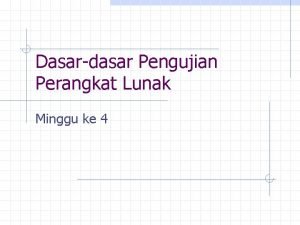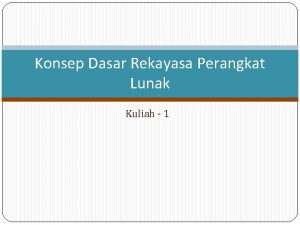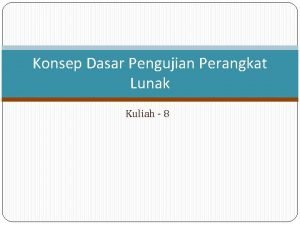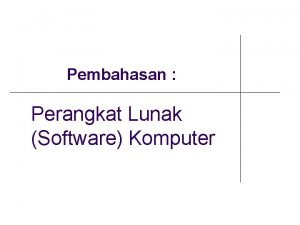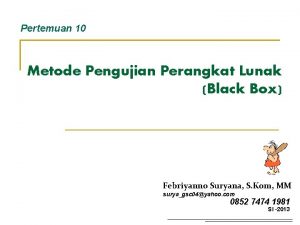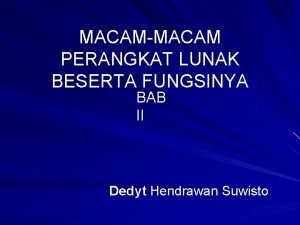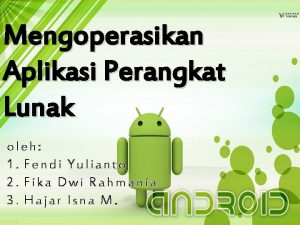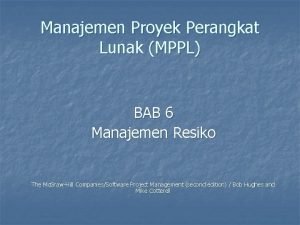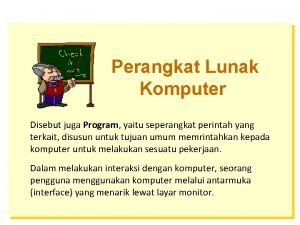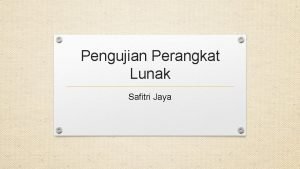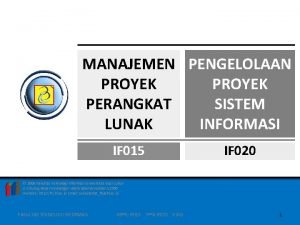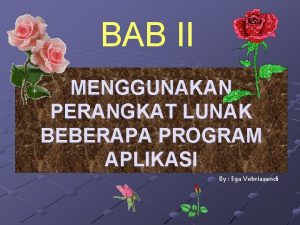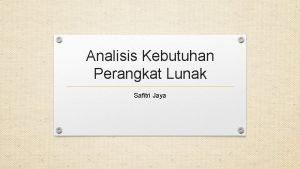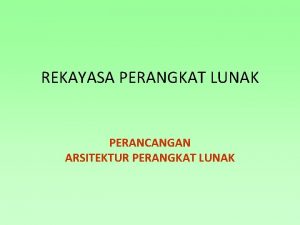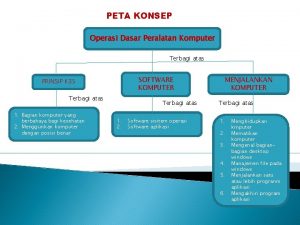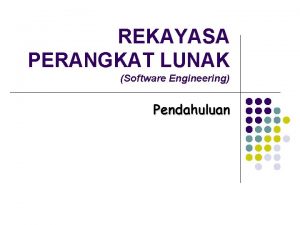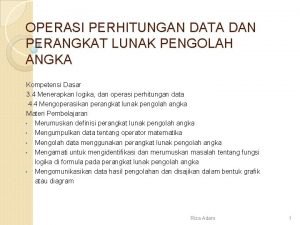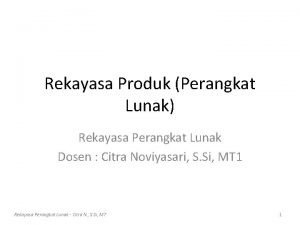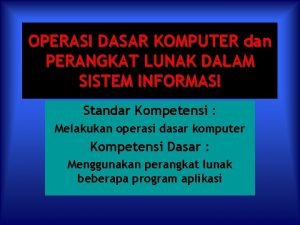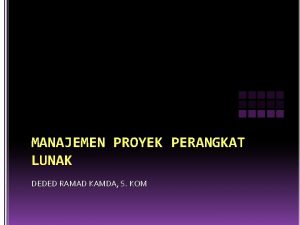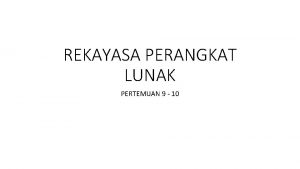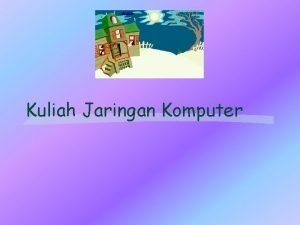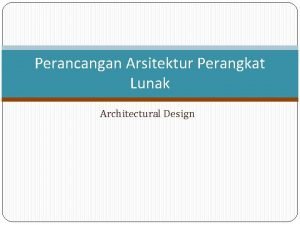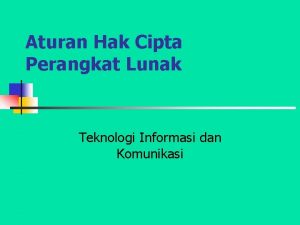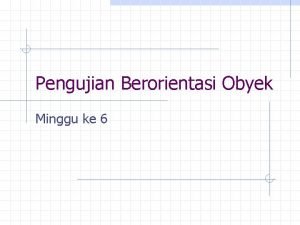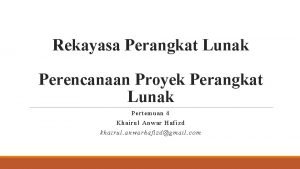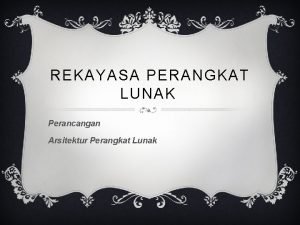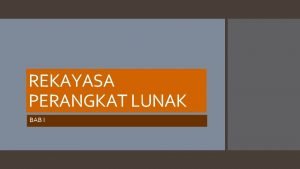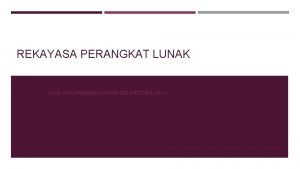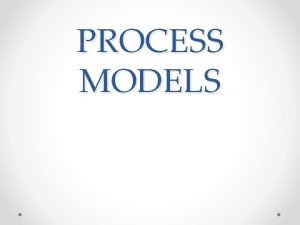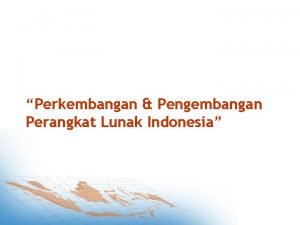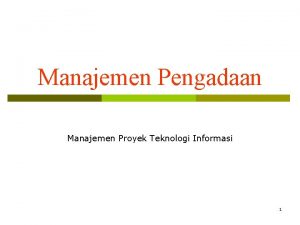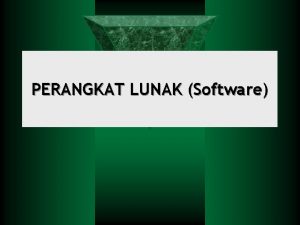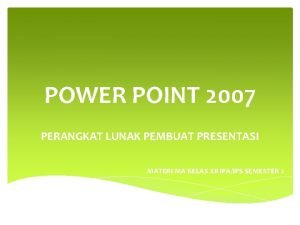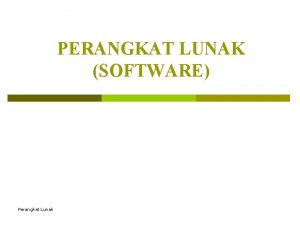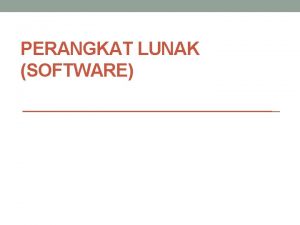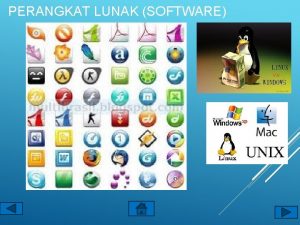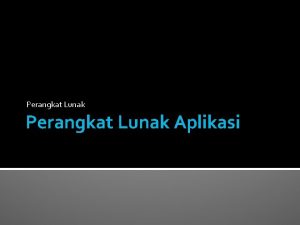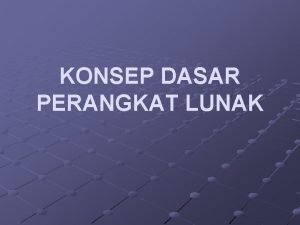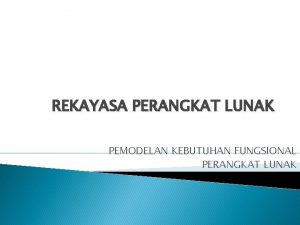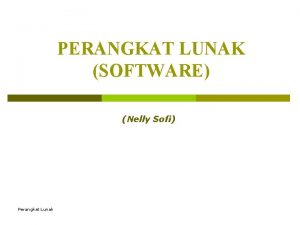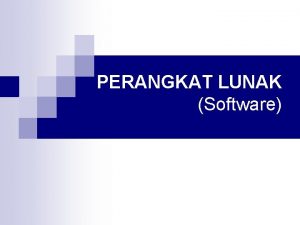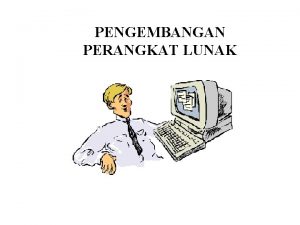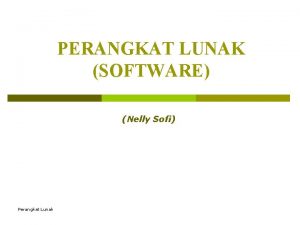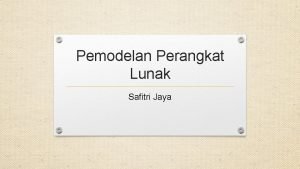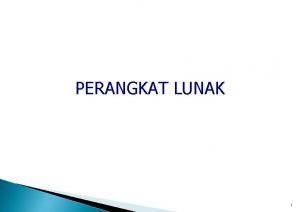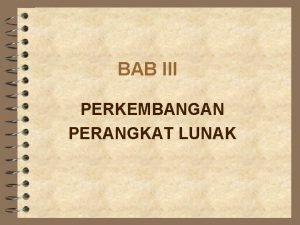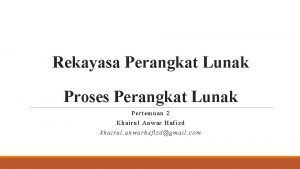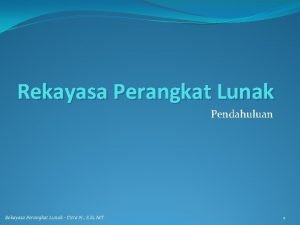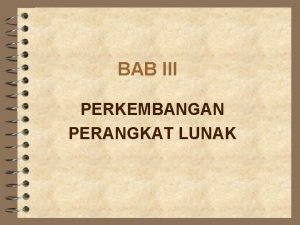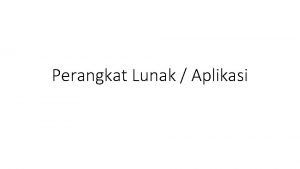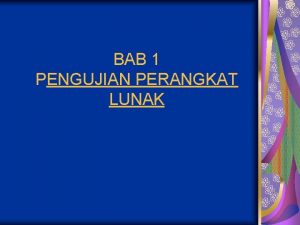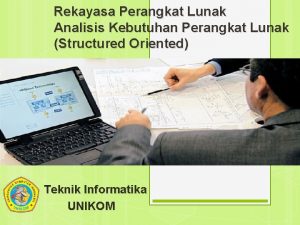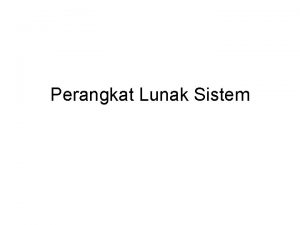Pemodelan Perangkat Lunak Dasar dasar UML UML Unified














































- Slides: 46

Pemodelan Perangkat Lunak Dasar – dasar UML

UML Unified Modelling Language Memvisualisasikan dan mendokumentasikan hasil analisa dan desain. Unified karena … Mengkombinasika metode OO yg sudah ada sebelumnya (Booch by Grady Booch, OMT by Jim Rumbaugh and OOSE by Ivar Jacobson) Modelling karena… Digunakan terutama untuk memodelkan sistem secara visual Language karena … Berisi sintak yang digunakan untuk memodelkan pengetahuan

What is UML? Bahasa untuk menangkap dan menggambarkan pengetahuan Perangkat untuk menemukan dan membangun sistem. Perangkat untuk memodelkan pembangunan sistem secara visual Perangkat yang populer

and…What UML is not! Bahasa pemrograman visual (IDE) Perangkat pengolah database SDLC Perangkat yang bisa memecahkan semua permasalahan. Garansi kualitas

What UML can do for you Help you to: Memudahkan berpikir dan mendokumentasikan sistem sebelum mengimplemntasikannya “meramalkan” sistem Menurunkan biaya pembangunan Merencanakan dan menganalisa logika sistem(perilaku) Membuat keputusan yang benar sedini mungkin (sebelum melangkah ke coding) Men-deploy sistem lebih baik, karena ada perencanaan penggunaan memori dan prosesor yang efisien. Lebih mudah memodifikasi/mengelola sistem yang terdokumentasi dengan baik. Biaya perawatan yang rendah Membuat suatu bentuk komunikasi yang standar

UML components UML Views Functional Non-functional Organisational Diagrams 9 diagrams (see further on) Model Elements Symbology / notation General Mechanisms Adornments Notes Specifications

UML diagrams Use-Case Static Structure Object Class Interaction Sequence Collaboration State Activity Implementation Component Deployment

UML Diagrams Use-Case (relation of actors to system functions) Class (static class structure) Object (same as class - only using class instances – i. e. objects) State (states of objects in a particular class) Sequence (Object message passing structure) Collaboration (same as sequence but also shows context - i. e. objects and their relationships) Activity (sequential flow of activities i. e. action states) Component (code structure) Deployment (mapping of software to hardware)

UML Diagram Philosophy UML diagram: Menggambarkan konsep Dalam bentuk simbol Menggambarkan hubungan/relasi antar konsep Berupa garis Menggambarkan nama Label dibawah atau samping suatu simbol dan garis

The Main 4 UML Diagrams Use-Case Class Sequence State

The Use-Case Diagram

The Class Diagram

The Sequence Diagram

The State Diagram

The Other 5 UML Diagrams Object Collaboration Activity Component Deployment

The Object Diagram

The Collaboration Diagram

The Activity Diagram

The Component Diagram

The Deployment Diagram

UML Relationships

UML Development Model UML DM Requirements Gathering Analysis Design Development Deployment

Pemodelan Perangkat Lunak UML - Use Case Diagram

Use-Case Diagrams (UCDs) A use-case is… Penyederhanaan dari business process model a set of activities within a system Dihadirkan dalam sudut pandang masing – masing aktor. (aktor yang berinteraksi dengan sistem) What is the model supposed to do? Memberikan notasi yang sederhana dan terbatas Bisa digunakan oleh diagram lain.

Use-Case Diagrams (UCDs) Components: use-cases and actors Use-case harus selalu membawa suatu nilai kepada aktor Keseluruhan dari use-case merupakan fungsi komplit dari sistem tersebut Tujuan: Konsolidasi kebutuhan fungsional sistem Memberikan dasar untuk ujicoba sistem Memberikan peta fungsi operasi dasar

UCD Components The use case itself is drawn as an oval. The actors are drawn as little stick figures. The actors are connected to the use case with lines. System Use-case symbol Actor symbol «extend» System boundary «include» Relationships and connectors

UML Actors An actor Is a class that forms a system boundary participates in a use-case is not within our responsibility as systems analyst/s and/or designer/s Examples are end-users (roles) external systems (co-operations) time related events (events) external, passive objects (entities)

UML Actor Classification A primary actor uses the system's primary functions (e. g. a bank cashier); A secondary actor uses the system's secondary functions (e. g. a bank manager, system administrator); An active actor initiates a use-case; A passive actor only participates in one or more use-cases.

Identifying UML Actors Ask yourself the following questions: Who are the system’s primary users? Who requires system support for daily tasks? Who are the system’s secondary users? What hardware does the system handle? Which other (if any) systems interact with the system in question? Do any entities interacting with the system perform multiple roles as actors? Which other entities (human or otherwise) might have an interest in the system's output?

UML Actor Notation and Generalisation Examples Staff Clerical staff Academic staff The guy Support staff «actor» The guy

UML Use-Cases (UCs not UC Diagrams UCDs) Definition: “Suatu rangkaian himpunan dari suatu aksi pada sebuah sistem yang memberikan hasil suatu nilai yang dapat diamati oleh aktor tertentu. “ Use-case characteristics: Selalu diawali oleh seorang aktor (sengaja atau tidak) Harus memberikan nilai yang dapat dilihat oleh aktor Harus membentuk suatu fungsi konseptual yang komplit (conceptual completion is when the end observable value is produced)

UC Description Criteria Use-Case Number (ID) and Name Use-case actors pre- and post-conditions invariants non-functional requirements Behaviour modelled as: - Described by - activity diagram/s decomposition in smaller UC diagrams error-handling and exceptions Rules modelled as: - activity diagram/s services examples, prototypes, etc. open questions and contacts other diagrams

UC Description Example UC: Login authentication User Disable access - Enable access Logged in user = valid user Login delay; line security Behaviour modelled as: - Invalid login name; interrupt entry Rules modelled as: - activity diagram/s decomposition in smaller UC diagrams activity diagram/s Log, pass prompts; authenticate examples, prototypes, etc. open questions and contacts other diagrams (realisations)

Activity Diagram from previous

Sub-UCs to Login Example

Rules Activity Diagram Example

Consolidating UC Descriptions Konsolidasi dengan menjawab pertanyaan ini: Apakah semua aktor yang berinteraksi dengan UC memiliki komunikasi (berupa relasi) yang berasosiasi dengannya? Apakah ada aturan / role umum diantara aktor? Apakah terdapat kesamaan UC? Apakah semua fungsi sistem dipenuhi oleh UC?

UCD Relationships (1/2) Association relationship Extend relationship «extend» Include relationship Generalisation relationship «include»

UCD Relationships (2/2) Associations ▪ Menghubungkan aktor dengan UC nya Use (or include) ▪ Gambar garis dari UC dasar ke UC yang harus dilibatkan, menunjukkan kebutuhan fungsionalitas dari suatu UC dengan yang lain Extend ▪ Gambar garis dari UC tambahan ke UC dasar, menunjukkan perilaku pilihan yang dapat dilibatkan. Generalisation ▪ Gambar garis dari UC khusus ke UC dasar, menunjukkan hubungan dari UC khusus ke UC yang lebih umum.

UCD Relationship Example (1/2)

UCD Relationship Example (2/2) «extend» make an interview elicit customer needs «include» produce a SRS

What a UCD is - and what it isn’t Attention focuser on the part of the business process that is going to be supported by the IS. It is the end-user perspective model. It is goal driven Helps to identify system services. Are not used as DFDs. Sequences, branching, loops, rules, etc. cannot (and should not) be directly expressed. Are often combined with activity diagrams, which serve as their refinement.

UCD Case Study (1/3) Vending Machine After client interview the following system scenarios were identified: ▪ A customer buys a product ▪ The supplier restocks the machine ▪ The supplier collects money from the machine On the basis of these scenarios, the following three actors can be identified: ▪ Customer; Supplier; Collector

UCD Case Study (2/3)

UCD Case Study (3/3) Introducing annotations (notes) and constraints.

Testing UCs Verification Confirmation of correct development according to system requirements. Validation (only when working parts become available) Confirmation of correct system functionality according to end-user needs.
 Dasar dasar pengujian perangkat lunak
Dasar dasar pengujian perangkat lunak Contoh perangkat keras dan lunak
Contoh perangkat keras dan lunak Dasar dasar rpl
Dasar dasar rpl Dasar pengujian perangkat lunak
Dasar pengujian perangkat lunak Perangkat lunak terbagi menjadi
Perangkat lunak terbagi menjadi Presentasi administrasi perkantoran power point
Presentasi administrasi perkantoran power point 5 metode pengujian perangkat lunak
5 metode pengujian perangkat lunak Macam macam perangkat lunak dan fungsinya
Macam macam perangkat lunak dan fungsinya Mengoperasikan aplikasi perangkat lunak
Mengoperasikan aplikasi perangkat lunak Proyek perangkat lunak
Proyek perangkat lunak Makalah black box testing
Makalah black box testing Program-program komputer disebut juga dengan istilah
Program-program komputer disebut juga dengan istilah Pengujian perangkat lunak
Pengujian perangkat lunak Pengelolaan proyek perangkat lunak
Pengelolaan proyek perangkat lunak Winamp termasuk dalam kelompok aplikasi
Winamp termasuk dalam kelompok aplikasi Perangkat lunak dbms adalah
Perangkat lunak dbms adalah 3 jenis kebutuhan perangkat lunak
3 jenis kebutuhan perangkat lunak Contoh arsitektur perangkat lunak
Contoh arsitektur perangkat lunak Peta minda jaringan komputer
Peta minda jaringan komputer Rekayasa perangkat lunak
Rekayasa perangkat lunak Operasi perangkat lunak pengolah data
Operasi perangkat lunak pengolah data Lapisan rekayasa perangkat lunak
Lapisan rekayasa perangkat lunak Proses perangkat lunak
Proses perangkat lunak Perangkat lunak aplikasi pengolah kata
Perangkat lunak aplikasi pengolah kata Sistem operasi dasar komputer
Sistem operasi dasar komputer Contoh wbs proyek aplikasi
Contoh wbs proyek aplikasi Wbs software project management
Wbs software project management Teknik perancangan perangkat lunak
Teknik perancangan perangkat lunak Perangkat lunak jaringan komputer
Perangkat lunak jaringan komputer Pengertian manajemen proyek perangkat lunak
Pengertian manajemen proyek perangkat lunak Perangkat lunak yang bertugas mengkonversikan
Perangkat lunak yang bertugas mengkonversikan Perancangan arsitektur perangkat lunak
Perancangan arsitektur perangkat lunak Contoh wbs proyek perangkat lunak
Contoh wbs proyek perangkat lunak Undang undang hak cipta perangkat lunak
Undang undang hak cipta perangkat lunak Contoh pengujian berorientasi objek
Contoh pengujian berorientasi objek Perencanaan proyek perangkat lunak
Perencanaan proyek perangkat lunak Contoh arsitektur perangkat lunak
Contoh arsitektur perangkat lunak Proposal manajemen proyek perangkat lunak
Proposal manajemen proyek perangkat lunak Karakteristik perangkat lunak
Karakteristik perangkat lunak Tidak termasuk release microsoft word adalah
Tidak termasuk release microsoft word adalah Berikut pembahasan perangkat lunak, kecuali
Berikut pembahasan perangkat lunak, kecuali Rekayasa perangkat lunak berbasis komponen
Rekayasa perangkat lunak berbasis komponen Perkembangan perangkat lunak
Perkembangan perangkat lunak Contoh wbs
Contoh wbs Contoh pengadaan dalam sebuah proyek ti
Contoh pengadaan dalam sebuah proyek ti Perangkat lunak yang digunakan untuk memproses data adalah
Perangkat lunak yang digunakan untuk memproses data adalah Apa yang dimaksud perangkat lunak pembuat presentasi
Apa yang dimaksud perangkat lunak pembuat presentasi
